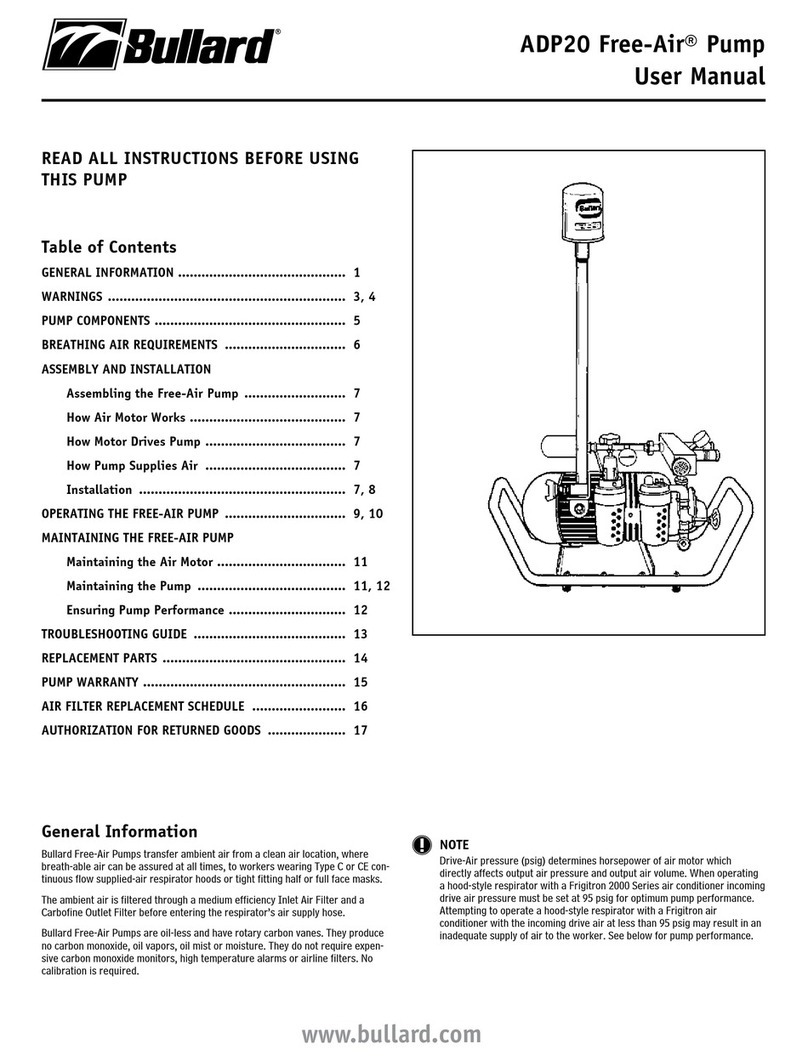
www.bullard.com
Free-Air® Pumps
Instruction Manual
7
Maintaining the Free-Air Pump/Troubleshooting Guide
Maintaining the Free-Air®Pump
Bullard Free-Air pumps consist of an electrically driven air pump with four
carbon vanes. The vanes self-adjust as they wear and should last from 5,000
to 15,000 hours if properly maintained.
For the pump to operate at its optimum performance level, the following
routine maintenance procedures must be performed:
1. REPLACE THE INLET AND OUTLET FILTERS REGULARLY
Dirty filters may inhibit air flow to the respirator(s), and cause the motor to
overload and decrease vane life.
- Replace the Carbofine outlet filter cartridge (Cat. No. S17101) at least once
every 200 running hours or sooner, if necessary.
- Replace the inlet filter (Cat. No. 23611) at least once every 500 operating
hours or sooner, if necessary.
2. FLUSH PUMP IF NECESSARY
Should excessive dirt, sand, foreign particles, moisture or oil be permitted
to enter the pump, the carbon vanes will become sluggish and the pump’s
performance will deteriorate. This will result in decreased outlet pressure or
failure of the pump to operate.
If the pump remains idle in a humid environment for a long period of time,
rust film may build up in the pump’s chamber and rotor slots. This will result
in decreased outlet pressure or a failure to operate at all.
If the above occurs, the pump should be flushed with the following
recommended solvent:
- Loctite Safety Solvent (Cat. No. S17931)
�WARNING
NEVER USE KEROSENE OR OTHER COMBUSTIBLE LIQUIDS OR VAPORS WITH THIS
PUMP. THEIR USE MAY RESULT IN AN EXPLOSION WHICH MAY CAUSE INJURY OR
DEATH.
Directions for Flushing Pump
a. Before flushing, disassemble and remove the following parts from the
pump:
- Disconnect the respirator’s air supply hose
- Remove the pump’s inlet filter
- Remove the pump’s outlet filter jar and outlet filter cartridge
b. With the pump running, pour several ounces of approved safety solvent
into the pump’s air inlet port. Repeat the flushing if necessary.
�WARNING
RUN THE PUMP FOR A SUFFICIENT TIME TO PURGE ALL TRACES OF THE SOLVENT
BEFORE REPLACING THE FILTERS, RECONNECTING THE AIR SUPPLY HOSE(S) AND
USING THE RESPIRATOR.
3. IN EVENT OF BROKEN VANES
Should you experience broken vanes in your Free-Air pump, it is important to
thoroughly clean out not only the rotor and drum, but also the inlet and outlet
filters.
Before cleaning
- Disconnect pump from power source
- Disconnect respirator’s air supply hose
- Remove the pump’s inlet filter
- Remove the pump’s outlet filter jar and outlet filter cartridge
- Remove the end plate which covers the rotor and drum
Remove any large pieces of vane which may still be located in the vane slots,
located on the rotor.
Next, tilt pump forward towards the ground (in the direction of the quick-
disconnect coupler), being careful not to impact ground, and allow any unseen
dust and debris to fall out of the pump. Jiggling and shaking to aid removal is
acceptable.
Use a can of compressed air, or a compressed air tool to spray air through
the air inlet port. Do the same in and around the rotor and drum, ideally
while in a forward tilted position to aid in removal. Finally, apply compressed
air to the outlet filter housing.
Repeat steps as necessary, until no further debris is emitted.
After no further debris is present, turn the rotor by hand in a clockwise
direction to ensure that the rotation is smooth, with no audible or felt grinding
or resistance. If grinding or resistance is felt, re-apply compressed air.
4. AVOID RUNNING THE PUMP AT EXCESSIVE PRESSURE
Avoid running the Free Air pump above 15 psig (103 kPa) for any length of
time. Running the pump above 15 psig (103 kPa) could cause motor damage
and will create premature wear of the carbon vanes.
NOTE
NEVER LUBRICATE THIS OIL-LESS PUMP. THE MOTOR BEARINGS
ARE GREASE PACKED AND SEALED. THEY REQUIRE NO FURTHER
LUBRICATION.
Free-Air Pump Trouble Shooting Guide
If your Bullard Free-Air pump is not working satisfactorily, please follow the
trouble shooting steps below:
Initial Checklist
1. You should be using Bullard V20 hose for Free-Air Pumps.
2. If using an extension cord, Bullard recommends 15 amp, 3-wire, 12 AWG
grounded extension cord up to 100 feet. Do not overload the circuit with
additional electrical equipment. The EDP10 requires at least a 7 kw
generator and the EDP16TE requires at least a 12 kw generator.
3. If using a Bullard cool tube, only the Frigtron 2000 is approved for the
EDP30 and ADP20. All other Free-Air Pumps do not support cool tubes.
SYMPTOM: Pump Fails to Start or Hums
1. Turn pump switch off and disconnect from the power source.
2. Check for the correct electrical current as shown on the motor plate and in
the Electric Motor Specification Chart on page 7 of this manual.
3. The pump is equipped with a thermal overload protector that turns the
current off when subjected to electrical overloads. Check to be sure that
the circuit is not overloaded by the pump and other electrical equipment.
4. Check to make sure that the carbon vanes move freely. If stuck to the
housing wall then flush with Loctite Safety Solvent.
5. Wait 15 minutes and restart.

































